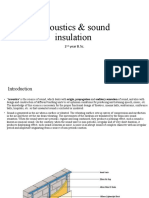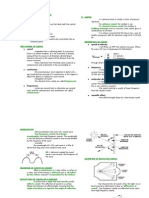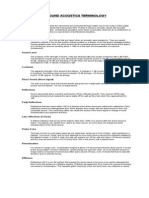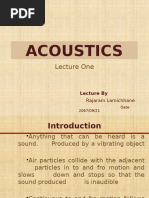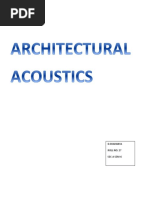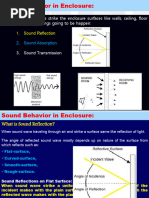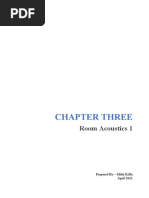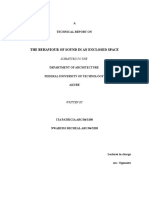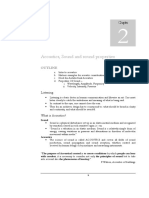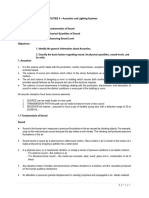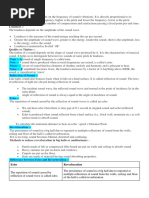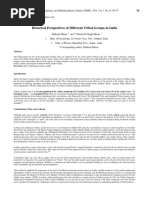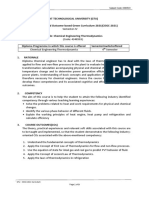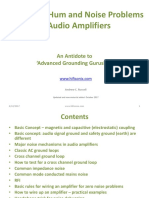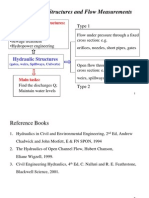Accoustics Notes
Accoustics Notes
Uploaded by
rutujaCopyright:
Available Formats
Accoustics Notes
Accoustics Notes
Uploaded by
rutujaOriginal Title
Copyright
Available Formats
Share this document
Did you find this document useful?
Is this content inappropriate?
Copyright:
Available Formats
Accoustics Notes
Accoustics Notes
Uploaded by
rutujaCopyright:
Available Formats
BUILDING SERVISES IV - ACCOUSTICS
WHAT IS ACCOUSTICS?
Acoustic is the science of sound which deals with the properties of sound
waves.
Some of the important applications in the field of engineering are electro-
acoustics, design of acoustical instruments and architectural acoustics.
Classification of sound
Sound waves are classified in 3 types.
1. Infrasound (f<20 kHz)
2. Audible sound (20 Hz<f<20 kHz)
3. Ultrasound (f>20 kHz)
CLASSIFICATION OF AUDIBLE SOUND
Audible sound is classified in two types.
(1) Musical sound :
The sound which produces pleasing effect on the ear is called musical sound.
Example : Sitar, violin, flute, piano, etc.
Properties of musical sound
The musical sound waveforms are regular in shape.
They do not undergo a sudden change in amplitude.
Characteristics of musical sound
1) Pitch- Related to frequency of sound.
2) Loudness- Related to intensity of sound.
3) Timber- Related to quality of sound.
(2) Noise
The sound that produces a jarring effect on the ear is called noise.
Example:-Sound of airplane, road traffic, crackers, etc.
Properties of noise
The noise waveforms are irregular in shape.
They undergo a sudden change in
amplitudes.
PROPERTIES OF SOUND
Pitch. the relative highness or lowness we hear in sound measurable by
vibrations per second.
Dynamics. degrees of loudness or softness in music.
SKNCOA Ar. Kalyani Nilesh Junankar
BUILDING SERVISES IV - ACCOUSTICS
Timbre. the quality of a tone that distinguishes it from other tones of the same
pitch.
Duration. the length of time in which vibration is maintained without
interruption.
Pitch
The frequency of a sound wave is what your ear understands as pitch. A higher
frequency sound has a higher pitch, and a lower frequency sound has a lower pitch.
For instance, the chirp of a bird would have a high pitch, but the roar of a lion would
have a low pitch.
The human ear can detect a wide range of
frequencies.
Frequencies from 20 to 20 000 Hz are audible to
the human ear.
Any sound with a frequency below 20 Hz is
known as an infrasound and any sound with a
frequency above 20 000 Hz is known as
an ultrasound.
Lists the ranges of some common animals
compared to humans.
Loudness
The amplitude of a sound wave determines its loudness or volume.
Larger amplitude means a louder sound, and smaller amplitude means a softer
sound.
The vibration of a source sets the amplitude of a wave.
It transmits energy into the medium through its vibration. More energetic vibration
corresponds to larger amplitude.
The molecules move back and forth more vigorously.
The loudness of a sound is also determined by the sensitivity of the ear.
The human ear is more sensitive to some frequencies than to others.
The volume we receive thus depends on both the amplitude of a sound wave and
whether its frequency lies in a region where the ear is more or less sensitive.
DEFFECTS OF SOUND
When the average sound intensity rises in to a suitable level in every part of the room
or auditorium with no echoes or disturbances or distortions.
This is called acoustic of building. To achieve this, one has to minimize the defects.
Following are the main defects of sound-
1. Formation of Echoes
2. Reverberation of Sound
3. Insufficient loudness
4. Sound focl
5. Dead spots
6. Outside or External disturbance
SKNCOA Ar. Kalyani Nilesh Junankar
BUILDING SERVISES IV - ACCOUSTICS
FORMATION OF ECHOES-
Echoes mainly produced due to the reflection of sound wave (mainly from the
surface of walls, roofs, ceilings etc.)
Echo is founded when the reflected sound reaches the ear at the same time when a
direct sound reaches. Echo causes disturbance and unpleasant hearing.
When Not all sound is absorbed, Some of it is reflected, That means sound bounces
off the solid matter example- a tennis ball bounces off a wall. Sound reflected back
to its source is an echo.
Echoes are the reflection of sound
from relatively flat object that is far
enough away that you can discern the time difference.
Echoes are used to measure distance, velocity, and the shape of objects.
Echoes off gratings result in an unusual pinging sound.
repetition of sound
The sensation of sound persists for 1/15th of a second after the source has
ceased. Thus an echo must reach after 1/10th second of the direct sound.
This defect can be removed by selecting proper shape of the hall.
And by providing rough and porous interior surfaces to disperse the energy of
echoes.
And by providing rough and porous interior surfaces to disperse the energy of
echoes.
This defect can be removed by selecting proper shape of the hall.
REVERBERATION
Is the time interval with in which , the intensity of sound produced or reverberation is
the multiple reflection in
an enclosed space .
The sound persists even
when the source of
sound has ceased or
stopped.
This prolongation of
sound in a hall even
though the source of
SKNCOA Ar. Kalyani Nilesh Junankar
BUILDING SERVISES IV - ACCOUSTICS
sound is cut off is called reverberation.
A sound produced in a hall undergoes multiple reflections from the walls, floor and
ceiling before it becomes inaudible.
1.Depends on the size of room as if room is small reflections will taken place quickly
as waves have to travel less distance, so time will be less.
2. Reverberant sound is the reflected sound , as a result of improper absorption.
3. Reverberation may results in confusion with the sound created next.
The time during which the sound persists is called the reverberation time of sound in
the hall.
reverberation time ‘t’ is given by formula :-
t= 0.16V /A where V=volume of room in cubic meters
A= total absorbing power of all the surfaces of room/ hall.
Reverberation time: Amount of time at a specific frequency that a sound in an
enclosed space takes to decrease 60 decibels in level after the source sound has
stopped.
Reverberation time & quality of sound
Reverberation time should remain within limits as per Indian Standard Code: 2526-
1963.
The time taken by the sound in a room to fall from its average intensity to inaudibility
level is called the reverberation time of the room.
Reverberation time is defined as the time during which the sound energy density falls
from its steady state.
SKNCOA Ar. Kalyani Nilesh Junankar
BUILDING SERVISES IV - ACCOUSTICS
SABINE’S FORMULA
Sabine defined the reverberation time as the time taken by the sound intensity to fall
to one millionth of its original intensity after the source stopped emitting sound.
t = reverberation time in second
V = volume in m3
A = (a1s1+a2s2+a3s3+……….) absorption unit of individual object
Material Absorption coefficient per m2
Open window 1.00
Ventilators 0.10 to 0.50
Brick wall 400 mm thk 0.03
Plaster on wall surface 0.02
Glass against solid surface 0.03
Marble 0.01
Stage curtain 0.20
Linoleum / concrete floor 0.03
Solid wooden floor 0.09
Framed wooden floor 0.13
Plywood on battens 0.17 to 0.26
Window glazed 0.18
Curtains in heavy fold 0.40 to 0.75
Metal 0.01
Audience, adults in wooden seat 0.46
Plain seat 0.02
Covered seat 0.10 to 0.20
SKNCOA Ar. Kalyani Nilesh Junankar
BUILDING SERVISES IV - ACCOUSTICS
INSUFFICIENT LOUDNESS
In case of theater or large auditoriums the speakers voice or music from the stage
should be easily audible in all parts of the hall at the uniform of intensity of loudness.
To achieve this,
the sound waves should be properly reflected and uniformally spread all over
the interior part of the auditorium.
But due to the lake of sound reflecting flat surfaces near the sound source or
stage and excessive absorption of sound in the hall resulting the defect of
insufficient loudness.
This defect can be minimized by providing hard surface near the stage absorbent
material should be provided as per the requirements.
Also the location of loudspeakers should be adjusted. So that there is no dead spots
and sound focl.
SOUND FOCL
Reflecting concave surfaces cause concentration of
the reflected sound wave at certain spot, creating a
sound of large intensity. These spots are called sound
focl.
This defect can be remove by :-
1. Geometrical designed shapes of the interior faces,
including ceilings.
2. Providing highly absorption materials on focusing
areas.
DEAD SPOTS
This defect is an outcome of the formation of sound focl.
Because of high concentration of the of reflected sound at spot focl, there is
deficiency of reflected sound at some other points.
These points are known as dead spots, where sound intensity is so low that is
insufficient for hearing.
This defect can be remove by Installation of suitable
diffuser and reflectors so that there is even distribution of
the sound in the hall.
OUTSIDE OR EXTERNAL DISTURBANCE
External noise from vehicles, traffic engines, factories,
cooling plants etc. may enter the hall either through the
openings such as doors windows, ventilators etc. or
through the walls and other structural elements having
improper sound insulation.
This defect may be removed by-
By using sound insulation material on the walls with
respect to the surroundings.
SKNCOA Ar. Kalyani Nilesh Junankar
BUILDING SERVISES IV - ACCOUSTICS
Sources of outdoor noises
Road traffic.
Railways.
Climatic conditions.
Aero planes.
Moving machines.
Machines in nearby factories or buildings etc.
Sources of in door noises
Indoor noises are those which are caused either in the same room or adjacent
rooms.
And these are due to:-
Conversation of peoples.
Moving of peoples .
Moving of furniture.
Crying of babies.
Playing of radios/ other musical
instruments.
Operations of water closets and
cisterns.
Noise of type writer
Banging of doors etc.
NOISE
Noise is unwanted sound which masks the satisfactory hearing of speech and music.
There are mainly three types of noises that are to be minimized.
They are
(i) air-borne noise,
(ii) structure-borne noise and
(iii) internal noise.
Air-Borne NOISE
The noise that comes into building through air
from distant sources is called air-borne noise.
A part of it directly enters the hall through the
open windows, doors or other openings while
another part enters by transmission through
walls and floors.
Remedies
The building may be located on quite sites
away from heavy traffic, market places,
railway stations, airports etc.
They may be shaded from noise by
interposing a buffer zone of trees, gardens
etc.
SKNCOA Ar. Kalyani Nilesh Junankar
BUILDING SERVISES IV - ACCOUSTICS
Structure-Borne NOISE
The noise which comes from impact sources
on the structural extents of the building is
known- as the structure-borne noise. It is
directly transmitted to the building by
vibrations in the structure.
The common sources of this type of noise
are footsteps, moving of furniture, operating
machinery etc.
Remedies
The problem due to machinery and
domestic appliances can be overcome by
placing vibration isolators between machines and their supports.
Cavity walls, compound walls may be used to increase the noise transmission loss.
Internal NOISE
Internal noise is the noise produced in the hall or office etc.
They are produced by air conditioners, movement of people etc.
Remedies
The walls, floors and ceilings may be provided with enough sound absorbing
materials.
The gadgets or machinery should be placed on sound absorbent material.
ACOUSTICAL MATERIALS
COMMERCIAL and CUSTOM DESIGNED building materials and surface treatment
which contribute significantly to acoustical control or to noise reduction
METHODS of ABSORPTION
GENERAL CLASSIFICATIONS
• Porous Materials
• Panel or Membrane Absorbers
• Cavity (Helmholtz) Resonators
SKNCOA Ar. Kalyani Nilesh Junankar
BUILDING SERVISES IV - ACCOUSTICS
POROUS MATERIALS
Soft, porous materials are very good sound absorbers. The basic acoustical
characteristic of these materials is a cellular network of interlocking pores. Within
these pores, incident sound energy is converted into heat.
Examples of these include acoustical boards, diffusers, soft plasters, mineral wool,
and acoustical blankets, among others.
Characteristic:
Their sound absorption is more
efficient at high, rather than
low frequencies. However,
their acoustical efficiency
improves in the low frequency
range with increased
thickness and with distance to
their solid backing.
Categories of Commercial Materials
Pre-fabricated Acoustical Units
Various types of perforated, fissured, or textured materials constitute typical units in
this group, Commonly used materials include
1. Acoustical boards:
These can be installed in several ways
Cemented to a solid backing
Nailed or screwed to wood framing
Laid in a ceiling suspension system
SKNCOA Ar. Kalyani Nilesh Junankar
BUILDING SERVISES IV - ACCOUSTICS
Advantages
Trade catalogs contain detailed
specifications
Easy installation & maintenance
Flexible absorption
Disadvantages
Difficult to conceal joints
between units
Soft structure subject to damage
Paint redecoration harmful to
absorption
2. Acoustic hangers
Acoustic Hangers or baffles- a system of fiber-board panels that are wrapped
with insulation and are hung freely using wire or rope.
SKNCOA Ar. Kalyani Nilesh Junankar
BUILDING SERVISES IV - ACCOUSTICS
3. Geocoustic tiles & panels
Geocoustic Tiles- special prefabricated units for random application on walls
and ceilings.
4. Diffusers
Absorptive material that have, irregular surfaces, or angled or curved fronts,
so when mounted on a wall or the ceiling they stop parallel wall interference
and prevent standing waves
SKNCOA Ar. Kalyani Nilesh Junankar
BUILDING SERVISES IV - ACCOUSTICS
PLASTERS and SPRAYED-ON MATERIALS
Acoustical Plasters and Sprayed-on Materials: Absorbent paint applied in a
semiplastic consistency. There are two types:
Type I: composed of a cementitious material such as gypsum, cement, or lime
Type II: Fibrous materials combined with a binder agent, sprayed on with an air gun
or blower
Advantages
May be used for irregular surfaces
Aesthetic and decorative qualities
Disadvantages
Difficult application
Difficult maintenance
ACOUSTIC BLANKETS-
Also referred to as “Isolation Blankets”. Materials manufactured from rock wool, glass
fibers, wood fibers, hair felt, etc.
SKNCOA Ar. Kalyani Nilesh Junankar
BUILDING SERVISES IV - ACCOUSTICS
ACOUSTIC FOAM BOARDS
High density blankets with covering; also act as diffusers
CARPETS and FABRIC
PANEL ABSORBERS
Also referred to as “Membrane Absorbers”. Impervious material installed in a solid
backing but separated from it by an air space.
CAVITY RESONATORS
Also referred to as “Helmholtz Resonators”. Materials that consist of an enclosed
body of air, confined within rigid walls and connected by a narrow opening to the
surroundings space.
SKNCOA Ar. Kalyani Nilesh Junankar
BUILDING SERVISES IV - ACCOUSTICS
Classifications
a) Individual Cavity Resonators
Standard concrete blocks, using regular concrete mixture, but with slotted cavities
b) Perforated Panel Absorbers
Perforated panels spaced away from a solid backing
c) Slit Resonators
Isolation blankets (or alternative) covered with slits, the whole system forming a
resonator
SKNCOA Ar. Kalyani Nilesh Junankar
BUILDING SERVISES IV - ACCOUSTICS
SPACE ABSORBERS-
Sound absorbing objects which are suspended from the ceiling, used when regular
boundary enclosures of an auditorium do not provide a suitable or adequate area
for conventional acoustical treatment.
VARIABLE ABSORBERS-
Sliding, hinged, movable, and rotatable panels constructed to expose either
absorptive or reflective surfaces.
SKNCOA Ar. Kalyani Nilesh Junankar
BUILDING SERVISES IV - ACCOUSTICS
Details to be examined in the selection of sound absorbing finishes
Sound Absorption / Noise Reduction Coefficient
Possible installation methods
Maintenance
Durability
Integration with room elements
Attraction to Vermin
Thermal Insulation values
Fire resistance
Cost and Availability
Aesthetics
SKNCOA Ar. Kalyani Nilesh Junankar
You might also like
- RA The Book Vol 1: The Recording Architecture Book of Studio DesignFrom EverandRA The Book Vol 1: The Recording Architecture Book of Studio DesignNo ratings yet
- Metal and Metal Alloys NotesDocument18 pagesMetal and Metal Alloys Notesrutuja75% (4)
- Thomas Kuhn, Rocks and The Laws of Physics (1997)Document10 pagesThomas Kuhn, Rocks and The Laws of Physics (1997)Steve PetersonNo ratings yet
- Sound Recording Unit 25 Lab 1 1Document19 pagesSound Recording Unit 25 Lab 1 1api-477227067No ratings yet
- Tribal Museum BhopalDocument3 pagesTribal Museum BhopalRutuj Parakh100% (5)
- HW Retaining WallDocument76 pagesHW Retaining Wallrutuja100% (1)
- Unit I Architectural AcousticsDocument36 pagesUnit I Architectural AcousticsMayur KotechaNo ratings yet
- AcousticsDocument14 pagesAcousticsReji K DhamanNo ratings yet
- Assignment 2: List of Acoustical DefectsDocument6 pagesAssignment 2: List of Acoustical DefectsRaj MaheshwariNo ratings yet
- Acoustics 39898001Document6 pagesAcoustics 39898001LokeshNo ratings yet
- Acoustics & Sound Insulation: 2 Year B.SCDocument14 pagesAcoustics & Sound Insulation: 2 Year B.SCKomal ChopadaNo ratings yet
- Architectural Acoustic: Prepared By:-Rushit PatelDocument32 pagesArchitectural Acoustic: Prepared By:-Rushit PatelSaurabh SinghNo ratings yet
- AcousticsDocument15 pagesAcousticsVanessa FernandesNo ratings yet
- AcousticsDocument42 pagesAcousticskkanishk320No ratings yet
- Reveiw Arch-2010 Acoustics and LightingDocument15 pagesReveiw Arch-2010 Acoustics and LightingiloilocityNo ratings yet
- Acoustics 01Document15 pagesAcoustics 01Ybette Anorico VillamarinNo ratings yet
- Acoustics and LightingDocument16 pagesAcoustics and LightingDaryl Gomez TimatimNo ratings yet
- Bs 3 Unit 5aDocument28 pagesBs 3 Unit 5aPavithra SivasankaranNo ratings yet
- 05A - Sound InsulationDocument17 pages05A - Sound InsulationRitikaNo ratings yet
- Acoustics and PlumbingDocument14 pagesAcoustics and PlumbingCes Dela CruzNo ratings yet
- Module-3-Acoustics - DN-for StudentsDocument26 pagesModule-3-Acoustics - DN-for Studentsbhargav.kotagalNo ratings yet
- Unit I Introduction To Acoustics (12 Hours) : Characteristics of SoundDocument12 pagesUnit I Introduction To Acoustics (12 Hours) : Characteristics of SoundRupa RajNo ratings yet
- Acoustics PDFDocument15 pagesAcoustics PDFAllen YumangNo ratings yet
- Acoustics 101Document8 pagesAcoustics 101Charles NukesevenNo ratings yet
- Acoustics 1Document12 pagesAcoustics 1krishnabhardwaj8910No ratings yet
- ACOUSTICSDocument35 pagesACOUSTICSSachin Kumar PatelNo ratings yet
- B V SEM Lecture 1 (Acoustic Intro Class)Document14 pagesB V SEM Lecture 1 (Acoustic Intro Class)Nirajan RaiNo ratings yet
- Acoustics of Enclosed SpaceDocument47 pagesAcoustics of Enclosed SpaceAnusha Ivaturi0% (1)
- Character of SoundDocument35 pagesCharacter of SoundVinayak DodagoudarNo ratings yet
- Acoustics NoteDocument7 pagesAcoustics Notesusmita sethiNo ratings yet
- Unit 2 AcousticDocument37 pagesUnit 2 AcousticAbhi VallabhaneniNo ratings yet
- Acoustics (2) 27 PDFDocument5 pagesAcoustics (2) 27 PDFSharanyaNo ratings yet
- Unit 2 Part 3 AcausticDocument7 pagesUnit 2 Part 3 AcausticSmita DasNo ratings yet
- Behavior of Sound-3Document13 pagesBehavior of Sound-3Prof. Petta Eswara RoNo ratings yet
- Acoustics 190214091010Document26 pagesAcoustics 190214091010aiah bitolinamisaNo ratings yet
- Acoustics 4-30-09Document115 pagesAcoustics 4-30-09vdchaudhariNo ratings yet
- AcousticsDocument28 pagesAcousticsKanika Maheshwari100% (1)
- Chapter ThreeDocument16 pagesChapter ThreeMilat KifluNo ratings yet
- Behaviour of Sound in An Enclosed SpaceDocument14 pagesBehaviour of Sound in An Enclosed Spacesanchit gupta100% (1)
- 3rd LectureDocument26 pages3rd LectureAhmed AbotaheenNo ratings yet
- Auditorium Acoustics 101: by Arthur NoxonDocument4 pagesAuditorium Acoustics 101: by Arthur NoxonMani MuruganNo ratings yet
- Acoustics NotesDocument6 pagesAcoustics NotesvipinNo ratings yet
- Room Acoustics: Bouncing AroundDocument45 pagesRoom Acoustics: Bouncing AroundmanigupthaNo ratings yet
- Acoustic For Civil EnggDocument4 pagesAcoustic For Civil EnggBRGRNo ratings yet
- Acoustics: Reception PropagationDocument13 pagesAcoustics: Reception PropagationVince MurilloNo ratings yet
- Acoustics, Sound and Sound Properties: OutlineDocument25 pagesAcoustics, Sound and Sound Properties: OutlineSHREYA LOHAKARENo ratings yet
- Acoustics FundamentalsDocument115 pagesAcoustics FundamentalsAnthony Van Tejano SacabinNo ratings yet
- Sound: Behavior in Closed SpacesDocument48 pagesSound: Behavior in Closed SpacesSharanya100% (1)
- Unit IiiDocument55 pagesUnit IiiNaveen KumarNo ratings yet
- ACOUSTICSDocument5 pagesACOUSTICSSchwarzNo ratings yet
- Acoustics of Concrete in BuildingsDocument12 pagesAcoustics of Concrete in BuildingsChen Yaohui Victor100% (1)
- U1 ACOUSTICS UTRASONICS and DIELECTRICS 2024 25 S1-1-8Document8 pagesU1 ACOUSTICS UTRASONICS and DIELECTRICS 2024 25 S1-1-8siddkamble2004No ratings yet
- Arch 322 ModuleDocument14 pagesArch 322 ModuleGANITANO HEZEL, A.No ratings yet
- E1972 13983 Chapter 4 Ultrasound and AcousticDocument26 pagesE1972 13983 Chapter 4 Ultrasound and AcousticTarun KumarNo ratings yet
- Sound Notes 9 BDocument3 pagesSound Notes 9 Bsmi_santhoshNo ratings yet
- SoundDocument5 pagesSoundShubhamSoodNo ratings yet
- Accoustics - 2021: 1. Fluttering of SoundDocument3 pagesAccoustics - 2021: 1. Fluttering of Soundlima chakkuNo ratings yet
- Acoustics PPTDocument22 pagesAcoustics PPTankiw89100% (1)
- RA The Book Vol 3: The Recording Architecture Book of Studio DesignFrom EverandRA The Book Vol 3: The Recording Architecture Book of Studio DesignNo ratings yet
- RA The Book Vol 2: The Recording Architecture Book of Studio DesignFrom EverandRA The Book Vol 2: The Recording Architecture Book of Studio DesignNo ratings yet
- Adventures in Sound with Max Axiom Super Scientist: 4D An Augmented Reading Science ExperienceFrom EverandAdventures in Sound with Max Axiom Super Scientist: 4D An Augmented Reading Science ExperienceNo ratings yet
- Fire Fighting NotesDocument25 pagesFire Fighting NotesrutujaNo ratings yet
- ZFVDXHBTDDocument127 pagesZFVDXHBTDrutujaNo ratings yet
- The Mantralaya Fire, Mumbai: A Case StudyDocument6 pagesThe Mantralaya Fire, Mumbai: A Case Studyrutuja100% (1)
- NFPA Case Study: Nightclub FiresDocument45 pagesNFPA Case Study: Nightclub Firesrutuja100% (4)
- Earthquake Resistant Structure - NOTES 3rd YR V SEMDocument12 pagesEarthquake Resistant Structure - NOTES 3rd YR V SEMrutuja100% (1)
- 8 Glass-2Document27 pages8 Glass-2rutujaNo ratings yet
- Historical Perspectives of Different Tribal Groups in IndiaDocument10 pagesHistorical Perspectives of Different Tribal Groups in IndiarutujaNo ratings yet
- SKN College of Architecture Stamp Scale Sign DateDocument1 pageSKN College of Architecture Stamp Scale Sign DaterutujaNo ratings yet
- THE Top View of Life: Front Cover PageDocument33 pagesTHE Top View of Life: Front Cover PagerutujaNo ratings yet
- All About MHADA Housing SchemeDocument2 pagesAll About MHADA Housing SchemerutujaNo ratings yet
- Sweden Wants To Closely Partner With India in Trade, Technology & Investment - EnvoyDocument12 pagesSweden Wants To Closely Partner With India in Trade, Technology & Investment - EnvoyrutujaNo ratings yet
- SynopsisDocument4 pagesSynopsisrutujaNo ratings yet
- Tribes of Maharashtra: Rajagopal Devara, Secretary, Tribal Development Department, Maharashtra State, INDIADocument19 pagesTribes of Maharashtra: Rajagopal Devara, Secretary, Tribal Development Department, Maharashtra State, INDIArutujaNo ratings yet
- Major Tribes in India - Check State-Wise Tribes List Here! - CDS & Defence ExamsDocument9 pagesMajor Tribes in India - Check State-Wise Tribes List Here! - CDS & Defence ExamsrutujaNo ratings yet
- Population.-According To This ScheduleDocument9 pagesPopulation.-According To This SchedulerutujaNo ratings yet
- Culture and Heritage - Folk and Tribal Art - Know India - National Portal of IndiaDocument6 pagesCulture and Heritage - Folk and Tribal Art - Know India - National Portal of IndiarutujaNo ratings yet
- Slum Reason PDFDocument73 pagesSlum Reason PDFrutujaNo ratings yet
- Slum Reason PDFDocument73 pagesSlum Reason PDFrutujaNo ratings yet
- Impulse and MomentumDocument3 pagesImpulse and MomentumsinghashubhadeepNo ratings yet
- Microcontroller Based High Voltage Pulse Electric Field Generator For PasteurizationDocument3 pagesMicrocontroller Based High Voltage Pulse Electric Field Generator For Pasteurizationijsret0% (1)
- Schaeffler Technical Pocket GuideDocument716 pagesSchaeffler Technical Pocket Guideionut76733100% (2)
- Chemical Engineering Thermodynamics Subject Code: 4340503Document9 pagesChemical Engineering Thermodynamics Subject Code: 4340503Solanki DarshitNo ratings yet
- The Metaphysics of Music Spanning The MiDocument78 pagesThe Metaphysics of Music Spanning The MiДмитрий ШийкаNo ratings yet
- CC15 Laminar FlowDocument22 pagesCC15 Laminar Flow999impactNo ratings yet
- How To Wire Up A Power Amplifier October 2017Document37 pagesHow To Wire Up A Power Amplifier October 2017Rodolfo MarchantNo ratings yet
- Physics Dictionary KSSMDocument51 pagesPhysics Dictionary KSSMMimie Sulaiman100% (1)
- Critical Speed of TurbineDocument1 pageCritical Speed of Turbinepurna100% (1)
- Acoustic Band Gaps and Elastic Stiffness of PMMA Cellular SolidsDocument30 pagesAcoustic Band Gaps and Elastic Stiffness of PMMA Cellular Solidswajahat khanNo ratings yet
- Methods For Power Factor ImprovementDocument7 pagesMethods For Power Factor ImprovementClint PaulNo ratings yet
- Syllabus 2021-2022: 1. Static Equilibria, Stress, and StrainDocument9 pagesSyllabus 2021-2022: 1. Static Equilibria, Stress, and StrainKrrish Pradhani9C11No ratings yet
- Unit-5: Reciprocating Compressors: 5.1 Uses of Compressed AirDocument12 pagesUnit-5: Reciprocating Compressors: 5.1 Uses of Compressed AirSamrudh Manjunath100% (1)
- Solutions To Assignment 4Document11 pagesSolutions To Assignment 4Sandeep SajuNo ratings yet
- Absorption Chiller IntroductionDocument34 pagesAbsorption Chiller Introductiontan0314100% (1)
- Dimensionless Numbers in Fluid MechanicsDocument7 pagesDimensionless Numbers in Fluid MechanicsNAJAMUL HassanNo ratings yet
- Physics of Roller Coasters: Royal High School Physics, Fall 2007Document10 pagesPhysics of Roller Coasters: Royal High School Physics, Fall 2007زوہیب ارمانNo ratings yet
- Mitigations To Flow Induced Vibration (FIV) in Control Valve Piping System Using Visco-Elastic Dampers & Neoprene PadsDocument7 pagesMitigations To Flow Induced Vibration (FIV) in Control Valve Piping System Using Visco-Elastic Dampers & Neoprene PadsIJSTENo ratings yet
- Drop Breakup in A Symmetric T-Junction Microchannel Under Electric Field-1Document11 pagesDrop Breakup in A Symmetric T-Junction Microchannel Under Electric Field-1Bhavesh DhapolaNo ratings yet
- Topic by TopicDocument287 pagesTopic by TopicA.Benson0% (1)
- 2017 Linear Elastic Lateral Buckling & Linear Elastic Lateral Torsional Buckling-DerksDocument20 pages2017 Linear Elastic Lateral Buckling & Linear Elastic Lateral Torsional Buckling-DerksOmar AvilaNo ratings yet
- Kenyatta University: April 10, 2019Document124 pagesKenyatta University: April 10, 2019SIMON JOSIAHNo ratings yet
- My ThesisDocument107 pagesMy ThesisbekirovichNo ratings yet
- Science and Its Times Vol.6 - 1900 To 1949 (652s)Document652 pagesScience and Its Times Vol.6 - 1900 To 1949 (652s)Rubén García Díaz100% (3)
- CHP 05Document10 pagesCHP 05Dimitri KaboreNo ratings yet
- Week 8 10 Hydraulic Structures Part I WEIRSDocument50 pagesWeek 8 10 Hydraulic Structures Part I WEIRSgeorgedytrasNo ratings yet
- Lecture Notes in Schrodinger's EquationDocument5 pagesLecture Notes in Schrodinger's EquationGemay DanglayNo ratings yet
- Physics Now de Jon OgbornDocument159 pagesPhysics Now de Jon OgbornFrancisco GurrolaNo ratings yet
- Chapter 2 ConductionDocument29 pagesChapter 2 ConductionAbo AbdoNo ratings yet










